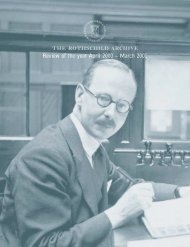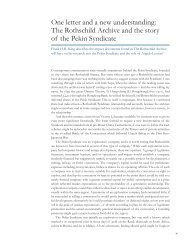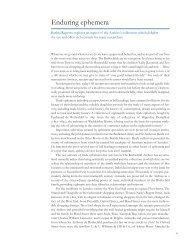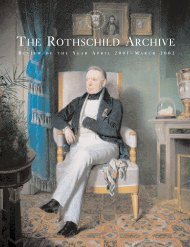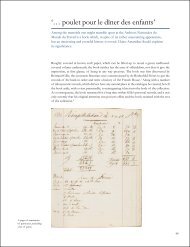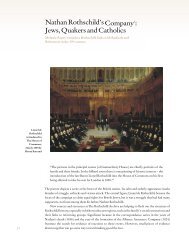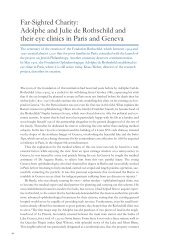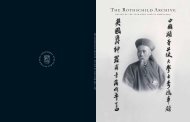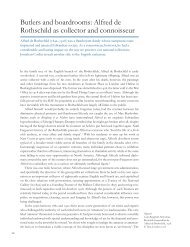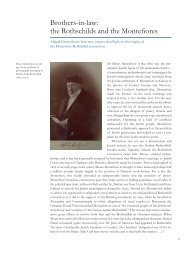66900 Rothschild Archive - The Rothschild Archive.
66900 Rothschild Archive - The Rothschild Archive.
66900 Rothschild Archive - The Rothschild Archive.
Create successful ePaper yourself
Turn your PDF publications into a flip-book with our unique Google optimized e-Paper software.
Takahashi Korekiyo, the <strong>Rothschild</strong>s<br />
and the Russo-Japanese War, 1904–1907<br />
Richard Smethurst recalls the genesis of the relationship between the <strong>Rothschild</strong><br />
banks and one of the great figures in Japan’s history, Takahashi Korekiyo.<br />
Economic historians know Takahashi Korekiyo (1854–1936) best for his countercyclical monetary<br />
and fiscal policies during the Great Depression of the 1930s. Takahashi, who served as<br />
governor of the central bank, prime minister and seven times as finance minister between 1913<br />
and his assassination in 1936, devalued the yen, lowered interest rates, increased the money<br />
supply, and began substantial deficit financing in 1931–1932, five years before John Maynard<br />
Keynes published his seminal General <strong>The</strong>ory of Employment, Interest, and Money. Takahashi’s policies<br />
were so successful in engineering Japan’s economic recovery that one of his biographers,<br />
Gotō Shin’ichi, has dubbed him ‘Japan’s Keynes’. ₁<br />
Takahashi, who began his study of English at the age of ten with American missionaries in<br />
Yokohama, built his successful bureaucratic and political career on the basis of his knowledge<br />
of the primary foreign language of the time. Born the illegitimate child of a shogunal court<br />
artist and a 15-year old family maid, Takahashi was adopted as an infant into the lowest rank<br />
of the warrior class. Accordingly, Takahashi received very little formal education – we have no<br />
evidence that he attended school at all. Although we have a letter to his parents from San<br />
Francisco, written when he was 14, we do not know where he learned to read and write<br />
Japanese. Ability to speak colloquial English was his key to upward mobility. He began his first<br />
job, as an English-language instructor at Daigaku nankō, a forerunner of Tokyo Imperial<br />
University, in 1869, teaching older and better-educated superiors in the samurai pecking order.<br />
In the 1870s, while still a teenager, Takahashi interpreted for David Murray, an American advisor<br />
to the Meiji government, and helped translate Alfred Marshall’s <strong>The</strong> Pure <strong>The</strong>ory of Modern<br />
Trade. In the 1880s, he wrote, and then after a year of research in the United States and Europe,<br />
rewrote Japan’s first copyright and patent laws, served as the founding commissioner of his<br />
nation’s patent office, and managed one of Japan’s initial overseas industrial ventures, a (failed)<br />
silver mine in Peru. In the 1890s, as a fledgling central banker, he helped in the process of<br />
Japan’s entry onto the gold standard. During the war with Russia in 1904–1905, he sold £82 million<br />
of Japanese war bonds, almost half the cost of the war, in London and New York to<br />
British, American, and later German investors. After the war in 1905–1907, he negotiated in<br />
Europe the issuance of £48 million more in bonds, largely through the London and Paris<br />
<strong>Rothschild</strong>s. In 1906–1915, successively as vice governor and then governor of the Bank of<br />
Japan, finance minister, and political party leader, he strove to limit government spending to<br />
avoid Japan’s defaulting on its wartime bonds – these efforts included opposition to railroad<br />
nationalisation in 1906, to the addition of two divisions to the army in 1912, and to the infamous<br />
Twenty-one Demands to China in 1915. After the war, as finance minister and premier,<br />
Takahashi attempted to devolve much of the central authorities’ power to local government,<br />
and played a key role in the rise of Japan’s political parties to power. Throughout the second<br />
half of his career, Takahashi fought courageously for civilian control of the army and navy, and<br />
against excessive military spending, which led to his murder by young officers in 1936.²<br />
<strong>The</strong> subject of this essay is one chapter in Takahashi’s fascinating life: his dealings with the<br />
<strong>Rothschild</strong> family in 1904–1907. I have written elsewhere about Takahashi’s efforts to sell<br />
Japanese war bonds in 1904–1905, so let me be brief here.³ Shortly after Japan’s war with Russia<br />
20



